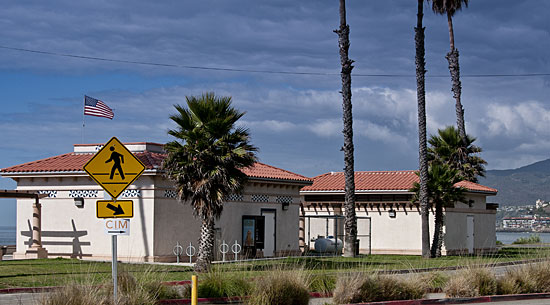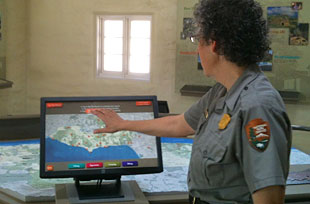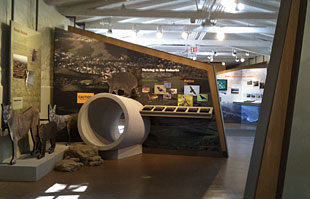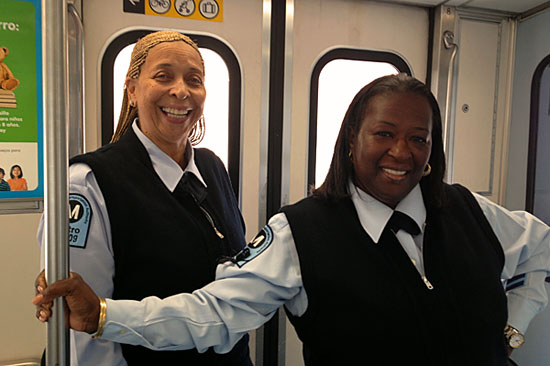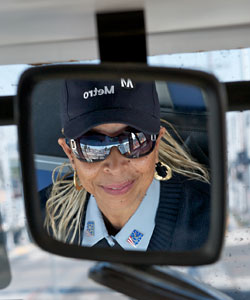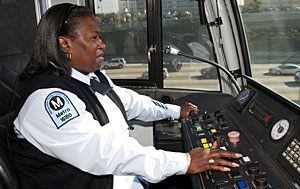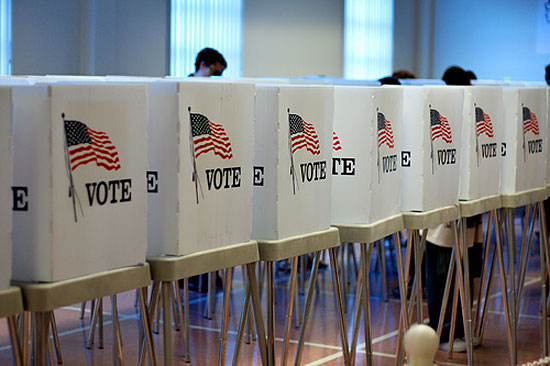Wilshire ramps by the numbers
June 6, 2012
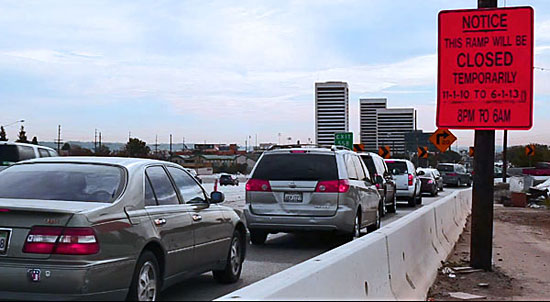
Thousands of accidents, millions of lost "person hours" sitting in traffic: that's life on the 405 and Wilshire.
It’s not just a local gripe magnet. The 405 Freeway has a national reputation—and it’s not a nice one. “Somewhere between notorious and terrible,” says Tim Lomax, a senior research engineer for the Texas Transportation Institute. When you throw in the upcoming closure of the 405 ramps at Wilshire Boulevard for a long-running construction initiative that starts June 22 as part of the 405 Project, you’ve got a long-simmering recipe for making motorists stew. Here are some of the ingredients that make this the intersection we love to hate:
- Vehicles traveling on Wilshire: An average of 105,721 vehicles a day cross the intersection of Wilshire and Sepulveda Boulevard, right next to the freeway
- UCLA-bound students and staff traveling through the area: 20,000 (summer), 25,000 (academic year)
- Busiest ramp in the morning: exit ramp from the northbound 405 to eastbound Wilshire, with 1,494 vehicles an hour at peak of morning commute time
- Busiest ramp in the afternoon: westbound Wilshire onramp to the southbound 405, with 1,301 vehicles an hour at peak of afternoon commute time
- Number of “Top 40” appearances in the Texas Transportation Institute’s 2011 Congested Corridors Report: 6, out of 7 possible categories. The 13.1 mile corridor of the 405 that runs from the 105 Freeway to Getty Center Drive—and includes the Wilshire intersection—ranks among the worst in the country for heavy congestion, truck traffic and jammed conditions during the morning, midday, afternoon and weekend periods.
- “Person hours” lost to traffic delays in the corridor: 12.6 million a year
- Fuel wasted: 6.057 million gallons annually
- Congestion cost in time and fuel: $269.9 million a year
- How bad travel times in the area will be after construction starts: Plan on everything taking twice as long, at least at first.
- Likelihood the person in the car next to you during those traffic delays will be eating: 39.13% of motorists admit to eating or drinking behind the wheel, a survey found.
- Likelihood the person in the car next to you will be talking on the phone: 30.1% say they chat while driving.
- Likelihood they’ll be texting or putting on makeup: Just 8.6% and 2.95%, respectively.
- Best public transportation option: Metro’s 761 bus, which runs from the Valley to Westwood
- Total number of ramps to be rebuilt: 8
- First two ramps up for closure: westbound Wilshire onramp to the northbound 405 and northbound 405 off-ramp to westbound Wilshire
- Cost of rebuilding those two ramps: $2.65 million
- Overall cost of the entire 405 Project: $1.034 billion
- How long it will take to finish the ramp work: approximately 1 year, including the time it will take to build new “flyover ramps” intended to make the intersection move better and more safely.
- Number of project nicknames so far: 2, Ramp Jam and The Rampture.
Sources: Los Angeles Department of Transportation, Los Angeles Police Department, California Highway Patrol, Caltrans, Metro, Texas Transportation Institute’s 2011 Congested Corridors Report; insurance.com, UCLA
Posted 5/16/12
Expo opens to Culver City on June 20
June 5, 2012
The Expo Line hits full strength on June 20, when the light rail’s Farmdale and Culver City stations open to the public.
The opening completes the 8.6-mile first phase of the line, which debuted with stations originally extending as far west as La Cienega on April 28. A second phase to extend the line all the way to Santa Monica is now being built.
The elevated Culver City station opens up a gateway to the city’s popular eateries and other attractions, including the quirky Museum of Jurassic Technology.
The Farmdale station, near Dorsey High School, was not originally part of the line, but was added later, after the Public Utilities Commission approved a station at the site. The Culver City station, original conceived as an interim station for phase one, changed course and became an elevated, permanent station after state funding became available.
Expo CEO Rick Thorpe said a 600-space park-and-ride lot will open along with the Culver City station, and bus lines in the area will be realigned to feed into it.
“It should be a very, very heavily used station,” he predicted.
The stations will open at noon on Wednesday, June 20. That means that participants can ride Expo to Culver City’s Third Wednesday “Summer Solstice” Happy Hour, with attractions including music from a six-string electric cello, an open house at the Kirk Douglas Theatre, dancing and all kinds of liquid refreshment at local watering holes.
Posted 6/5/12
Rollin’ on the river
June 5, 2012
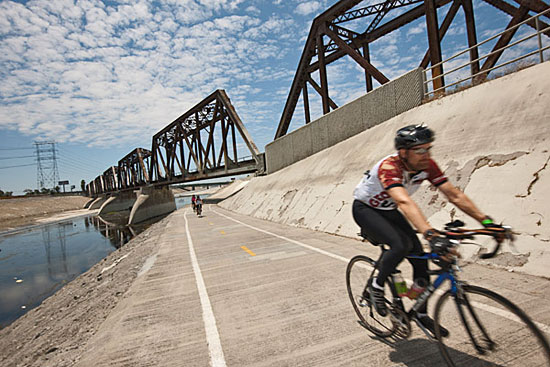
The L.A. River Ride bridges the past, present and future of the cycling revolution. Photo/Minami Pictures
Years before Los Angeles streets went car-free for the freewheeling festivities known as CicLAvia, bike advocates were already forging a path with the L.A. River Ride.
Now in its 12th year, the L.A. River Ride, which takes place on Sunday, is not just the granddaddy of local cycling activism. It’s also riding a growing wave of bike popularity, with new and veteran riders pedaling together in celebration of a still-evolving regional cycling culture.
“Committed cyclists ride by ourselves every day,” said Joe Linton, one of the event’s founders, along with Ron Milam and Chuck Arnold. “Group rides make us feel more connected with each other—and are a great way to welcome newer, less experienced riders into the fold.”
Since its beginning, the ride has generated support for two causes—bike advocacy and the health of the L.A. River. The event is now the yearly fundraiser for the Los Angeles County Bicycle Coalition, a nonprofit bike advocacy organization.
“We were one foot in river activism and one foot in bike activism,” Linton said.
In the late 1990s, before the first River Ride, the three activists organized a series of prototype events with Friends of the L.A. River and Occidental College. According to Linton the events were successful, and gave bikers a chance to see a “natural” side of the L.A. River.
“One of the big things about the L.A. River is that people don’t know where it is,” said Linton. “I think a lot of people imagine it is all concrete like in the movies Terminator and Grease.”
Although the ride draws attention to the river, its main thrust has always been about expanding bikeways. To help get federal funding for the inaugural River Ride in 2001, Linton pitched the goal of a continuous 50-mile bike path along the river, from the San Fernando Valley to Long Beach.
In 1998, around the same time the ride was beginning to take shape, Linton and Milam co-founded the Los Angeles County Bicycle Coalition. According to J.J. Hoffman, a coalition member who has organized the River Ride since 2005, the event and the organization have grown in symbiosis. The first ride drew 780 cyclists. When the bike coalition expanded in 2007, attendance doubled. Organizers expect this year’s event to draw about 2,500 cyclists.
The goal of a 50-mile continuous path along the L.A. River remains elusive, but there has been progress. When the event began there were 18 miles of bike path, built in the 1970s. Now there are nearly 30 miles of path, with another 1.5 miles to be added later this year as the West Valley River Bike Path moves towards completion. When the Metro Orange Line Extension to Chatsworth opens on June 30, 4 miles of bike path perpendicular to the river will open with it, eventually connecting to a part of the river path planned for the future. Hoffman says the cycling community is eager to keep adding to the total.
“Having 50 miles of uninterrupted bikeway in Los Angeles would be like having our own bike freeway,” said Hoffman.
This year’s ride takes place on Sunday, June 10. Registration starts at 6:30 a.m. The route will take riders along the river where path currently exists, and will detour around parts of the river where there’s no path yet. Security will patrol the route with radios to ensure riders stay safe. Helmets are required, and technical and medical support will be available along the ride.
There are 7 different ride options to choose from, from a 100-mile Century Ride to a 15-mile Family Ride and an even shorter Kids’ Ride. Registration ranges from $50 to $65 except for the Kids’ Ride, which is free. Most rides begin and end at the Autry Center in Griffith Park, where festivities will be held, including an International Food Fair, an “Eco Expo,” live music and a raffle. Rest stops in Elysian Valley, Hollenbeck Park, Maywood Recreational Park, Dill’s Park and Long Beach Shoreline Park will also feature food, music and entertainment. Visit the event page for more details.
Cyclists are encouraged to raise money by having people sponsor their rides. For the first time, this year the top fundraiser will win a 10-day guided bike tour of the Tuscany coast in Italy, and runners-up will win bike parts and apparel. Those who want to support the cause but can’t join in can sponsor the ride or make a donation.
This year’s grand marshal, Bobby Gadda, serves as the President of the Board of Directors of CicLAvia. Gadda said both events offer something unique:
“Both CicLAvia and the River Ride are all about families enjoying biking in the streets, using the public space in a different way.”
This Sunday, Gadda will lead rides out from Griffith Park, high atop his famous tall bike. There will be a lot of folks behind him, and even more behind a growing, healthy movement from gas power to pedal power.
Posted 6/5/12
Assessor to take leave of absence
June 1, 2012
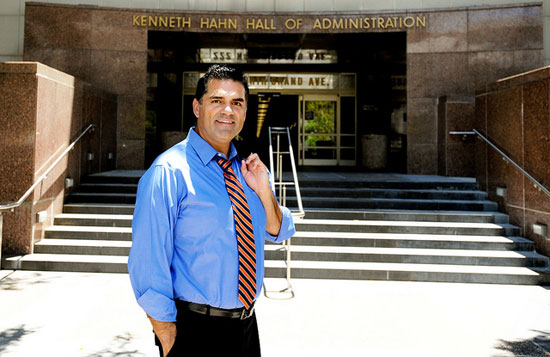
Noguez says he will begin a voluntary leave as soon as a Chief Deputy Assessor is named to run the office.
Los Angeles County Assessor John Noguez, buffeted by allegations that he gave preferential treatment to some property owners, announced today that he will take a leave of absence from his position as soon as a temporary successor can be appointed.
In a June 1 letter to the Board of Supervisors, Noguez said he is taking the voluntary leave “in the interest of restoring public confidence in the professionalism, integrity, and impartiality of the Assessor’s Office.”
“I do not take this decision lightly,” he wrote. “It is my sincere hope that the leave of absence will allow the Assessor’s Office to adhere to its mission during this important time.”
Noguez and members of his staff currently are being investigated by the D.A.’s public integrity unit. In his letter, Noguez said he and his office are cooperating with the probe.
Since the position of Chief Deputy Assessor currently is vacant, Noguez asked supervisors to designate “a highly qualified person” for the post to manage the office while Noguez is on leave. Noguez would actually make the appointment, but said in his letter that he preferred to stay out of the selection process in order to “remove any possible concerns” about his involvement.
Board of Supervisors Chairman Zev Yaroslavsky has introduced a motion directing the county’s Chief Executive Office to come up with candidates for the position. The motion, to be considered next week, calls for the board to discuss the candidates and recommend one of them for the job during open session.
In a statement, Yaroslavsky said Noguez made the right call in taking the leave of absence.
“Assessor Noguez’s decision to step aside allows for a new person to come in and restore order and integrity to an office that is currently shrouded in a cloud of uncertainty,” Yaroslavsky said. “His decision is in the best interest of the county, the Assessor’s Office, and the taxpayers.”
Posted 6/1/12
Clean sweep for beach restrooms
May 31, 2012
After last year’s riptide of bad publicity over cuts in the beach bathroom cleaning schedule, summer 2012 brings with it a full-on freshening up campaign for those oceanfront facilities.
Saying it is “ready to meet the demands of the busy summer season,” the county Department of Beaches & Harbors announced it would be reverting to its 2010 staffing model—and restoring those all-important 5 a.m. cleanings, seven days a week, that had been downsized because of personnel cuts last year.
Mid-day crews will be cleaning the restrooms every 60 to 90 minutes at the most heavily-used beaches on the busiest days of the week: Friday, Saturday, Sunday and Monday. And night crews will be coming onboard at 2 p.m. every day. In all, the county is responsible for 52 bathrooms at 17 beaches along the Los Angeles coastline.
Last year, the Board of Supervisors stepped in with $372,000 to bring on temporary workers to help keep the beach bathrooms clean. This year, temporary workers have again been hired under as part of a welfare-to-work program managed by the county’s Department of Public Social Services.
Posted 5/31/12
A mountain welcome
May 31, 2012
Few wilderness areas are as easy to visit as the Santa Monica Mountains—or as challenging for the average visitor to understand.
Sprawled over 153,000 acres and stretched along 44 miles of coastline, the Santa Monica Mountains National Recreation Area is part federal, part state and part local. Its ownership is an alphabet soup of government agencies and nonprofits; its internal boundaries are a public-private jigsaw puzzle.
Just figuring out which trails permit dogs can be a project. Yet the closest thing it has had to a visitor’s center has been a far-off office in a Thousand Oaks municipal complex.
Now, after years of planning and study, the nation’s largest urban national park finally has built a true, central gateway where the public can stop for information about its trails, beaches, amenities and wildlife.
On June 9, the Anthony C. Beilenson Interagency Visitor Center will open to the public in the heart of the recreation area, on the grounds of the former King Gillette Ranch near Calabasas.
“This is fantastic,” said Lisa Soghor, deputy executive officer for the Mountains Recreation and Conservation Authority, which manages the ranch and co-hosted a press tour this week in advance of the grand opening. “To have it here, at the heart of the mountains, in the center of the recreation area, is just really a dream come true.”
Los Angeles County Supervisor Zev Yaroslavsky agreed.
“The King Gillette property is one of the most beautiful in the Santa Monica Mountains,” said Yaroslavsky, whose 3rdDistrict includes the recreation area. “It’s centrally located in the national and state park, making it a great location for the Visitors Center. And it’s rightly named after former Congressman Anthony Beilenson, who had so much to do with the preservation of the Santa Monica Mountains.”
The new center, near the intersection of Las Virgenes Road and the Old Mulholland Highway, will also reflect the colorful history of one of Southern California’s most storied ranches. The Spanish-style building, erected in 1928, is the former horse stable of a 588-acre estate developed by King Camp Gillette, the razor-blade baron, and designed by famed Los Angeles architect Wallace Neff.
After Gillette’s death, the ranch—which he described as “paradise on earth, California style”—had a cavalcade of quintessentially Californian owners. MGM director Clarence Brown, partied and filmed on it from 1935 until the 1950s. Then it was sold to the Claretian Order of the Catholic Church, which used it as a seminary until the mid-1970s.
As urban development encroached on the mountains, neighboring homeowners lobbied the state to buy and preserve it. But in 1978, the land was sold to the Church Universal and Triumphant, a New Age doomsday sect that renamed it “Camelot” and moved its headquarters into the verdant, mountain-ringed valley.
That incarnation lasted until the mid-1980s, when the church moved to a remote plot in Montana, where members began preparing for Armageddon. (“You have 10 million auras in Los Angelesand here you have wide open space,” the church leader, Elizabeth Clare Prophet, explained.)
In 1986, Soka University of America, a liberal arts college financed by a Japan-based lay Buddhist organization, bought the ranch and announced plans to build a campus. But by now, local homeowners and environmental groups were organized enough to block the development. The appeals and lawsuits lasted until 2005, when an unprecedented coalition of government agencies, including Los Angeles County, raised $34 million to buy the land and turn it into the recreation area’s gateway.
“As with many important parkland acquisitions, it took more years and more battles than we had anticipated—but it also consolidated the resolve of state, federal and local park agencies to make this happen,” said Joe Edmiston, executive director of the Santa Monica Mountains Conservancy.
Until now, the ranch has been mainly been known as the site of the reality TV show, “The Biggest Loser,” which leases the estate’s property. This week, however, the new Visitor Center stepped into the spotlight, with rooms full of colorful displays and exhibits and a top-of-the-line LEED Platinum certification for environmental sustainability.
“We are proud to say that this is the first ‘net zero’ Visitor Center in the National Park System,” National Park Service Acting Superintendent Lorenza Fong noted, adding that the center will produce all of its own energy through a photovoltaic solar energy system. The historic building was remodeled and preserved with $9.5 million in federal stimulus grants.
Named for the congressman who introduced the 1978 legislation creating the recreation area, the center will be jointly staffed and managed by the recreation area’s major operators: the National Park Service, the California State Parks, MRCA and the Conservancy.
At the press tour, rangers proudly showed off the front desk made from recycled materials and a “virtual postcard” booth that allows visitors to photograph themselves against a background of the recreation area’s breathtaking scenery.
Most impressive, however, was an interactive display that cuts through the confusion over which rules apply in which sections of the recreation area’s vast network of parklands. It’s a useful tool, because, even on the trails around the Visitors Center, they change. Because the National Park Service allows dogs and the State Parks don’t, for instance, only the immediate grounds of the center allow pets on leashes; cross a bridge onto the parts of the recreation area owned by the state or MRCA, and dogs are forbidden.
“It’s still an issue,” laughed NPS Supervisory Park Ranger Barbara Applebaum, education supervisor for the center. But with a touch of the screen, she was able to highlight a host of places within the recreation area that were perfect for every variety of visitor—families, bicyclists, wildflower enthusiasts, serious hikers, swimmers and even canines.
The Visitor Center is at 26876 Mulholland Highway, Calabasas, and free to the public. The Grand Opening, with food trucks, live music and activities for all ages, will be June 9 from 10 a.m. to 4 p.m. For more information, call 805-370-2301 or visit www.nps.gov/samo. For directions and a flier, click here.

Posted 5/31/12
These smooth operators beat the guys
May 31, 2012
There are no bucking broncos or grease-painted clowns at this rodeo, and cowboy hats fall well outside the rigorous official dress code. There are, however, significant bragging rights on the line.
And this year, the challenge of lassoing some global recognition for the Metropolitan Transportation Authority at the International Rail Rodeo is in the train-tested hands of two women: Sheila Celestain and Carolyn Kelly.
The veteran Blue Line operators earned their trip to this week’s competition in Dallas by taking top honors in Metro’s in-house train rodeo earlier this year. They confronted obstacles on a closed rail course, mastered all the verbal and visual instructions that were thrown at them, and excelled in categories ranging from uniform inspection to train evacuation procedures to the smoothness of the ride.
Women have won Metro’s rail rodeo before—in 1998 and 2006—but this is the first time an all-female slate swept the internal contest, with the top two finishers earning the right to compete in “the show.”
Celestain, Metro’s top train operator this year, and Kelly, the runner up, are part of a culture in which women operators are still very much in the minority, and where the diplomatic skills needed to deal with thousands of daily passengers often are as essential as the technical finesse required to maneuver a 100,000-pound train car.
Women make up just 25% of the nearly 300 train operators currently on Metro’s staff.
But they often bring something special to the job, says rail division transportation manager Tom Jasmin.
“Over the years, I’ve noticed that women are more intuitive and they pay attention to detail more than I think men do,” he says. “They’re a little smoother on the braking, smoother on the acceleration…it’s just the smoothness of the ride you get. And when they get on the intercom, they’re a little more patient.”
Whatever happens in Dallas, it’s been quite a year for Metro’s top twosome. They were temporarily pulled off their Blue Line duties to become part of an elite crew chosen to test drive the new Expo Line as it prepared to open last month. They’ve transported VIPs, posed for photos with beaming officials and had their work immortalized in video. (Check out Celestain’s test ride with Supervisor Yaroslavsky here and catch a glimpse of Kelly driving the train on Expo’s inaugural run here.)
“Best year I’ve ever had since I worked for Metro,” says Celestain, who, like Kelly, is a 22-year Metro veteran who spent years driving a bus before making the leap to trains more than a decade ago.
If they’re worried about what’s coming their way at the international competition, it doesn’t show. In an interview Tuesday on the platform of Expo’s La Cienega station, both women seemed cool, confident and matter-of-fact. They also looked textbook-perfect: immaculately-pressed light blue shirts, dark sweater vests, regulation black shoes. (Hello, uniform inspectors.)
“I’m not sweating it at all. I’m gonna get in there and do what I’ve gotta do,” says Celestain, 56.
“I think we have a good chance,” adds Kelly, 54, who notes that the only potentially worrisome obstacle is having to use unfamiliar trains in Texas, not the Nippon Sharyo P865s and Siemens P2000s they drive at home.
Both credit their time on the Blue Line—Metro’s oldest, longest and busiest light rail—with giving them confidence to face whatever comes their way.
“Anything can happen on the Blue Line at any time,” Kelly says.
Adds Celestain: “After you work over here so long, you learn to just roll with the punches.”
Their boss, Jasmin, thinks working on the Expo opening also may have given the women an edge, since it required driving in a construction zone, where attentiveness and quick reactions are essential and pressure is high.
The competition takes place on Saturday, June 2. Celestain will be driving the train for the L.A. team in Dallas, and her score there will be combined with the scores that she and Kelly rack up in other categories, including a written test. Separate awards are given for operator teams and maintenance teams. In the latter category, Metro is represented this year by Charley Houck of the Blue Line, and Jose Padilla and Alan Addie of the Green Line.
The Metro train operators and “maintainers,” as they’re known, could also be in the running for the event’s annual Grand Champion Award, an honor last brought home by Metro in 2009.
Before they left for the big competition, Celestain and Kelly joked about sensing jealousy from the “haters” among their male colleagues. Just kidding: everybody is pulling for them, they say. But the guys—like the women themselves—do seem surprised the duo made it to the top their first time out as Metro rodeo contestants.
“They can’t believe it!” Celestain laughs. “They go every year, and this is the first year we went.”
Updated 6/5/12: Celestain and Kelly brought home the bronze, placing third behind train operators from Dallas and St. Louis. All of the winners were hailed as “stellar role models to their peers nationwide” by Michael Melaniphy, president and CEO of the American Public Transportation Association. “They are the best of the best in rail operations and maintenance,” he said.
Posted 5/30/12
The heat is on near new Orange Line
May 31, 2012
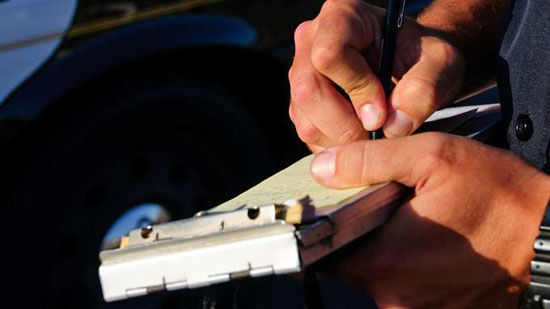
More than 100 tickets have been handed out in advance of next month's Orange Line Extension opening.
Sheriff’s deputies charged with making sure motorists, bicyclists and pedestrians stay safe around the soon-to-open Orange Line Extension have recently handed out 138 tickets—and counting—in the area around the new busway.
Their efforts have intensified recently, as the popular rapid transit bus line prepares to open its new, 4-mile route next month, extending the line from Warner Center to the train station in Chatsworth.
“Just this weekend alone, we did about 40 [citations],” sheriff’s Sgt. Ben Estrada said.
One of the biggest problems: motorists making illegal right turns on red across the busway.
“People are doing that like crazy. They’re ignoring [posted signs] completely, and risking a collision with a bus,” Estrada said.
Others try to beat a changing light but end up partially blocking the intersection—another ticket-worthy infraction.
Then there are those who manage to get into trouble on foot—using the busway as an impromptu running track. So far, deputies have issued only warnings to the joggers.
“They’re getting educated not to be jogging up and down the busway,” Estrada said. “For now, we’re just advising them. They’re not getting cited yet.”
Enforcement efforts have increased as Orange Line buses make trial runs on their new, dedicated busway in advance of an expected June opening. Updated 5/29/12: The Orange Line Extension is set to open to the public on June 30. A day of festivities and free rides is planned. Details are here.
Traffic collisions are not uncommon when new transit lines open, as motorists must adjust to new travel patterns. After the original Orange Line opened in 2005, a series of accidents led officials to convene a special committee to improve safety around the line.
This time around, an aggressive public education campaign is underway, drawing on earlier lessons learned.
Metro “safety ambassadors” have started working near schools in the area, observing pedestrian patterns and helping people navigate crossings.
An advertising campaign is planned for a range of San Fernando Valley publications, and flyers will be placed aboard Metrolink trains and distributed in locations where they’ll reach drivers, such as car washes and gas stations.
And, of course, nothing focuses a motorist’s attention like an expensive traffic ticket. Deputies on motorcycles and in patrol cars are out in force between the line’s Canoga Station, located at 6610 Canoga Ave., and the Chatsworth Metrolink Station, 10047 Old Depot Plaza Road, from now until several weeks after the line opens.
To stay out of trouble, “drive carefully and pay close attention to the signs and the red lights,” Sgt. Estrada advises.
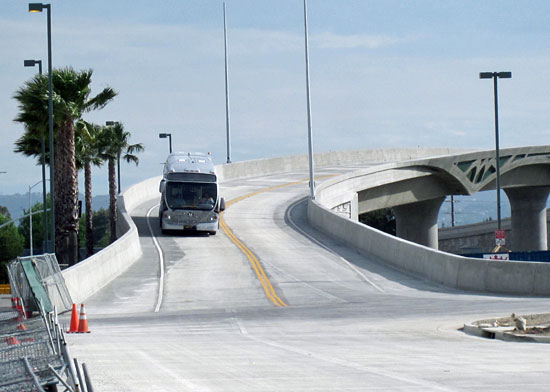
Test runs on the Orange Line Extension are already underway, and so is a new safety campaign. Photo/Metro
Posted 5/23/12
Don’t just vote—work at the polls
May 31, 2012
Venice is desperately seeking poll workers. So is Westwood. Ditto for Beverly Hills, Calabasas, Mar Vista and a host of other communities.
With the California primaries less than two weeks away, Los Angeles County Registrar-Recorder/County Clerk Dean Logan has put out a call for democratically-minded citizens to man the ballot boxes during the June 5 elections. Some 36 cities in Los Angeles County are short of volunteers, including Los Angeles, where precincts in more than 50 ZIP codes have reported shortages of two or more poll workers. (Click here and scroll down for a complete list of precincts that need workers.)
Many of the shortages are in high turnout areas of the Westside, though recruiting calls have gone out from Altadena to Westlake Village. Bilingual help is especially needed.
“Without poll workers, elections cannot function,” Logan says, noting that community volunteers “are essential to fair and open elections.”
Up to 25,000 poll workers are recruited to work in their respective election precincts each time the county holds a major election. Any registered voter who is over 18 and a resident of Los Angeles County can volunteer.
Workers are on duty from 6 a.m. to 9 p.m., setting up and closing the polls and assisting voters. They receive a stipend of up to $105.
Interested volunteers should apply by June 4. Additional information is available here and here. To apply, visit www.lavote.net or call 1-800-815-2666 (Option 7). Online application forms are also available here.
Posted 5/24/12






